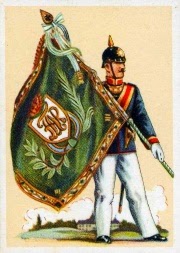This peacetime division was formed in April 1867
Its home station was in Saxony. Part of the XIX Corps District.
The 24th (2nd Royal Saxon) and 40th (4th Royal Saxon) Divisions formed the XIX Army Corps
47th (Royal Saxon) Infantry Brigade
|
|
139th (11th Royal Saxon)
Infantry Regiment, formed on 1st April 1887, garrisoned in Dobeln
|
|
179th (14th Royal Saxon) Infantry Regiment, formed on 1st April 1897, garrisoned in Wurzen
|
|
48th (Royal Saxon) Infantry Brigade
|
Transferred to the 58th Infantry Division as the 116th Infantry Brigade on 6th March 1915.
|
106th (7th
Royal Saxon) Infantry Regiment (King Georg), formed on 2nd June 1708, garrisoned in Liepzig
|
|
107th (8th
Royal Saxon) Infantry Regiment (Prinz Johann Georg), formed on 2nd June 1708, garrisoned in Liepzig
|
|
18th Ulhan Regiment
24th Field Artillery Brigade 1st Company, 22nd Pioneer Battalion |
77th Field Artillery Regiment
78th Field Artillery Regiment |
This Saxon Division was part of the 3rd German Army. Its first major engagement was at the battle of the Marne. The 48th Brigade was detached for a pr-emtive strike in northern Luxembourg.
In October 1914 it saw action with the 6th Army in Flanders.
In March 1915 the Division lost the 106th and 107th Regiments to the newly formed 58th Infantry Division. Gaining in replacement the 133rd Infantry Regiment from the 40th Division.
In continued to see action in the Flanders sector until August 1916, when it was sent to the Somme sector. It suffered very heavy losses, and in the two battles of the Somme it lost 69% of its strength.
At the end of 1916 the Division was withdrawn and returned to Flanders, taking its place in the line by January 1917.
Throughout 1917 it saw heavy combat in the Flanders sector, suffering serious casualties as a result.
In 1918 it was returned to the Somme sector and by May it was engaged in the Picardy sector. In August it resisted the French attack on the Avre sector. It ended the war in the St Quentin sector.





No comments:
Post a Comment